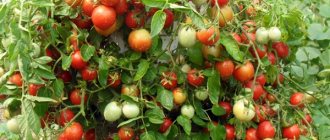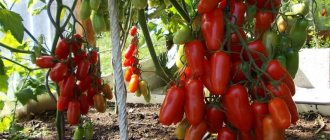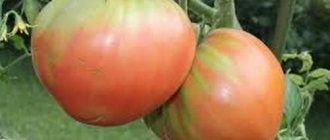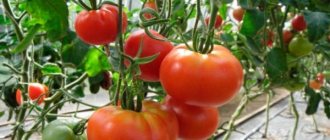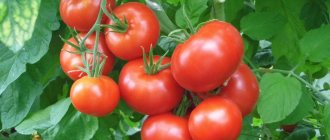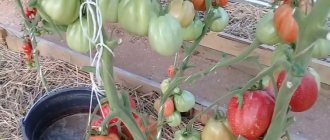Properties and Features of Tomato Cetus
Among other varieties, the “Cetus” pink tomato stands out for its unusual color and improved characteristics. When choosing seeds for planting, pay attention to this vegetable and learn more about it.
Features of the variety
This is a hybrid variety bred in Spain and is well suited for cultivation in various regions of Russia. It combines all the qualities necessary for tomatoes. It has an interesting taste and contains more vitamins than red tomatoes.
Source: Depositphotos “Cetus” tomatoes are tall varieties
When breeding the variety, the emphasis was on combining high taste qualities and growing efficiency. The result was the following characteristics:
- Fruit quality. They are dense and have a rounded-flat shape. The color is rich, with a crimson tint on top, pink in the cut.
- High yield potential. Tomatoes are early ripening, resistant to cladosporiosis, fusarium, verticillium and other major diseases, and easily tolerate heat and drought. The plant is well balanced. The fruits are collected in clusters of 6-8 pieces. The flowers are characterized by high viability, which ensures a good percentage of set and allows you to get up to 5 full-fledged tomatoes from the first bunch.
- Easy to care for. The bushes grow up to 2 m high, but are quite compact. Their leaves are sparsely spaced and the internodes are short. This reduces labor costs during the growing season.
- Good transportability. The strong skin and dense wall protect against damage during transportation. The fruits are resistant to cracking and are stored for a long time.
The root system of tomatoes is well developed. The plant turns out strong and has high growth energy, which allows you to get a yield that is 20% higher than the standard one.
How to grow
Tomatoes of this variety are classified as indeterminate. This means that they can be grown all year round in film and glass greenhouses of any height. Vegetables are propagated by seeds. After planting, the seedlings begin to bear fruit in 60-65 days.
The plant is unpretentious to agricultural technology, but compliance with growing rules ensures an increase in yield with a long rotation with planting in March-April and harvesting in September up to 25 kg/m². A short rotation allows you to quickly get 4-6 bunches, but the fruits will be smaller, and you won’t get more than 15 kg of tomatoes per 1 m².
The “Cetus” hybrid has successfully proven itself when grown by professional vegetable growers and beginning farmers.
The average fruit weight is 250-270 g, but by rationing the bunch and removing part of the ovary, you can get tomatoes up to 300 g. When planting, you need to maintain a distance between plants, fertilize and moisten the soil, and tie the stems to a support. This will preserve and increase the harvest.
The fruits of these tomatoes are beautiful and tasty. Their value increases due to early ripening and the content of useful substances.
Watch the video: Tomato Indigo Rose
How to grow seedlings
Preparing seedlings is simple; the main thing is to know the basic rules for growing them. As a rule, it is recommended to sow seeds 50-60 days before planting plants in the ground. To do this, select the appropriate seed, container and soil.
Seed preparation
When purchasing seeds, pay attention to the reputation of the manufacturer, and not to the bright and beautiful packaging. Study customer reviews or recommendations from neighboring gardeners and only then choose the right supplier
We do not recommend buying material in unverified places; it is best to contact specialized stores.
After purchasing, the seeds must be disinfected. This is done using aloe juice, hydrogen peroxide or a solution of potassium permanganate. Soak the seeds in one of the solutions for 24 hours, then place them on a cloth and dry well. Disinfection is a mandatory stage of seed preparation; it destroys dangerous microorganisms on the surface of planting material.
The next stage is hardening. Place the seeds in the freezer overnight and then leave them in the room for 10 hours. Repeat the algorithm several times and be sure that the plant will not be afraid of cold weather in the future.
After hardening, many gardeners germinate the seeds - place them in a damp cotton pad and leave in a dark place for 5-7 days. It is believed that with the help of germination, the general germination of seeds is checked and their immunity is strengthened.
Container and soil
Good soil should be loose and nutritious and meet the required acidity level. In addition, the soil must be well permeable to water and moisture. The composition of humus and chernozem in a ratio of 2:1 is recognized as an excellent mixture. For drainage, add 1 part of river sand or sawdust to such soil.
Any containers can be used: plastic cassettes, peat pots, plastic disposable cups, and so on.
Wash the container well and dry it, then treat it with hydrogen peroxide.
Sowing
Before sowing, make a drainage layer at the bottom of the container. This simple operation protects seedlings from root rot and blackleg. After drainage, pour the prepared soil into the container and water with warm water. Cover the container with film or thin glass and leave for 5-6 hours.
Then use a pencil or toothpick to make small holes in which to place the seeds. Sprinkle the grooves with soil, pressing down lightly. Use a spray bottle to moisten the grooves and cover the seedlings with film.
Growing and care
The seedlings are kept in a warm and bright place. The first week the air temperature should be at least 23 degrees. As soon as the sprouts have sprouted, the film is removed. Water the seedlings with warm filtered water as the soil dries
It is important to avoid excess moisture, as this leads to the risk of fungal infection.
After 7-10 days, the air temperature is reduced to 19 degrees Celsius. Regular ventilation is also necessary. After 2 weeks of planting seedlings in the ground, the container is taken out to the balcony for 1-2 hours, subsequently increasing the time. This way the seedlings are hardened off.
Seedlings must be fed. Ideally, combine mineral and organic fertilizers. Among organics, nettle solution or ash are considered an excellent remedy; among mineral complexes, it is recommended to use “Fitosporin+” or “Baikal”.
Cetus F1 - the tomato that everyone has been waiting for!
Cetus F1 - the tomato that everyone has been waiting for! Tomatoes appeared in our country more than 3 centuries ago. This berry immediately won first place among vegetables. The variety of tomatoes is very large: red, pink, yellow, round, plum-shaped. But in terms of taste, pink tomatoes are undoubtedly superior. Tomatoes contain tyramine, which in the body turns into the substance serotonin - the most powerful stimulant of mood and stress management, and pink tomatoes have the largest amount of it. The low calorie content of tomatoes helps obese people lose weight. This fruit is useful for the prevention of cardiovascular diseases and the digestive system, as well as salt deposits and kidney disease. And therefore, the pink tomato is the most popular vegetable for its excellent taste and beneficial properties.
Among Russian farmers, growing pink tomatoes comes first. The demand for it among buyers is always good, and the price, compared to red, is always higher. introduced this year a new pink tomato – Cetus F1, bred by specialists from the Spanish company Greenteam. The phrase “super beef” speaks for itself! You need a large pink tomato - this is Cetus F1. If you are looking for an ultra-ripe indeterminate hybrid, this is Cetus F1!
Fruitful and super-dense - this is Cetus F1! And, last but not least, aromatic and very tasty! By planting it in a greenhouse, in less than 65-70 days you will receive juicy bright pink fruits weighing 250 g. And when forming a cluster of five fruits, the weight reached 300-350 g. The density and keeping quality will pleasantly surprise you - the tomato has a dense wall over 8 mm and up to six chambers, this hybrid lacks the green spot, veins and stem inside. The complex design helps to retain water (weight) and at the same time remain solid. The stems are strong and can withstand a weight of more than 1 kg. Cetus F1 is suitable for cultivation both in spring-summer rotation and in summer-autumn rotation. As the experience of farmers in the Krasnodar region has shown, this hybrid has shown high resistance to cracking, as well as tolerance to common diseases. Cetus has good plasticity to growing conditions: it is suitable both for the south of Russia and for areas of risky farming. Based on the results of this season, farmers say with confidence that Cetus F1 is the pink tomato that everyone has been waiting for a long time.
Moskvichka landing
For high yields of Moskvich tomatoes, you need to rely on several rules for sowing seeds. Strong and healthy shoots are picked and then transplanted to a permanent place.
Terms and rules for sowing seeds
Moskvich tomatoes are grown in seedlings. To do this, preparatory work begins at the end of March or beginning of April.
In order for the planting material to germinate well and the sprouts to resist diseases, it is important to carry out several stages of preparation
The work consists of the following:
- Selection of barren flowers. In principle, purchased seeds rarely have barren flowers, since selection is carried out at production. Take 1 tsp per glass of warm water. salt. After complete dissolution, the grains are immersed in the solution. After 10 minutes, the floating seeds of the Moskvich tomato are drained along with water. Those remaining at the bottom are dried.
- Disinfection. To do this, use a weak 1% solution of potassium permanganate or a 2% solution of hydrogen peroxide. You can also use Chlorhexidine (no need to dilute with water). Planting material is soaked in potassium permanganate for 30-35 minutes, and in peroxide for 7-8 minutes. Then rinse and dry.
- Soaking in a growth stimulator. This is an important preparation step that will significantly improve the germination of grains. The seedlings will become strong and disease-resistant. The planting material is placed in a gauze bag and immersed in the prepared solution. They use drugs such as Zircon, Energen, HB-101 or Epin-extra. Honey is also a good growth stimulator. Dilute 1 tsp in a glass of warm water. bee product and soak the seeds for 5 hours. There is no need to rinse with water.
- Germination. Next, the planting material needs to be germinated. To do this, cover the bottom of the saucer with 3 layers of gauze and lay out the grains in one layer. Moisten with warm water from a spray bottle and make sure that the fabric does not dry out. Cover the top with a bag and place in a warm place where the temperature is at least 25°C.
After a few days, the Moskvich tomato seeds will begin to hatch. Sprouts will appear, and as soon as they reach a size of 3-5 mm, it is time to start planting seedlings.
To grow seedlings, use cups, wooden boxes or convenient pots. There must be holes at the bottom for liquid drainage. The containers are filled with soil mixture (purchased or prepared independently), moistened and the seeds are planted to a depth of 1.5 cm. Maintain a distance of 3 cm between planting materials.
The containers are covered with plastic wrap and placed in a shaded place with a temperature of 25-26°C. As soon as the tops of the future Moskvich tomato seedlings appear, remove the film from the container and transfer it to a sunlit windowsill.
Reference! The temperature should be around 14-16°C. This will prevent the sprouts from stretching, which will give strength to the root system. A week later, the temperature is raised again to 25°C.
Picking and transplanting seedlings
Digging Moskvich tomato seedlings involves transplanting sprouts from a smaller container to a larger one. Peat pots, paper or plastic cups specially made for seedlings are often used. It is necessary to make drainage holes at the bottom. During work, weak seedlings are also culled. The picking process is carried out when the first two cotyledon leaves appear.
Stages of work:
- The seedlings are watered 2 hours before picking. Spray with Epin solution to prevent stress in the plant and strengthen the immune system.
- Using a fork, carefully pry the Moskvich tomato seedling under the root and pull it out of the ground by the cotyledon leaves.
- The containers are filled more than half with soil mixture.
- Using a planting peg, holes are made and Moskvich tomato seedlings are placed in them up to the cotyledon leaves (along with a lump of soil).
- The soil around the stem is compacted and watered with warm, settled water.
- As soon as the seedlings take root, the container is placed on a windowsill illuminated by the sun or under an ultraviolet lamp.
Reference! In the case when plants are planted in a large common container, then a planting pattern of 8x8 cm is followed. The earth is first loosened, disinfected with a solution of potassium permanganate and sprinkled with wood ash.
Moskvich tomato seedlings are transplanted to a permanent place when the sprouts are 60 days old. The beds are prepared in advance. They adhere to a 40x50 cm planting pattern. This way the tomato bushes will not shade each other.
The seedlings are carefully removed from the glasses and planted in holes 20-25 cm deep along with a lump of earth. Then water and cover with soil. It is recommended to carry out work in the evening or on a cloudy day. There should be no wind or rain.
Description of the tomato variety Cetus pink, its characteristics and yield
The pink Cetus tomato is the development of Italian breeders, but in a short time it has become popular in Russia. Thanks to its strong survival qualities, today the variety is grown in various Russian regions. When breeding an indeterminate species, the goal was to combine excellent taste characteristics and high yields. The advantages of the new type are:
- high yield;
- rich tomato taste, which compares favorably with most traditional types;
- early fruit ripening;
- resistance to major tomato diseases;
- ability to withstand low temperatures and heat.
A distinctive quality of the new type is the unusual taste of vegetables, the content of vitamins in which is several times higher than traditional red tomatoes.
Description of tomatoes
Tomatoes have a characteristic round shape with a slight flatness. The fruits of the Cetus pink tomato have dense pulp and a rich crimson color. When cutting the vegetable, you can observe a bright pink tint.
From 6 to 8 fruits are formed in one brush. The inflorescences tolerate stress well and are able to maintain good setting properties even in difficult climatic conditions. Even the first brushes are capable of producing at least 5 tomatoes. Vegetables have a beautiful appearance and special color.
The average weight of vegetables reaches from 250 to 270 grams . By controlling the size of the clusters, it is possible to obtain fruits of 300 grams.
Thanks to their dense structure, the fruits are well stored and can withstand long-term transportation. Vegetables retain their aesthetic qualities and do not crack during storage.
Features of care
The height of the shoots reaches 2 meters, so the plant needs to be tied up. At the same time, the shoots combine tall growth and compactness. The bushes have a small number of leaves and short internodes, which makes caring for the plant easier.
The plant has a developed root system, therefore it does not require watering and is able to provide the shoots with a sufficient amount of nutrients. This ability makes it possible to increase the yield by 20% compared to traditional varieties. The ability to grow the variety year-round in glass structures is considered a strong quality.
The plant is grown in seedlings and begins to bear fruit 60–65 days after the appearance of the first shoots. If the growing rules are followed correctly, a plant can produce up to 25 kg of vegetables per 1 m². When planting seeds in March, the first fruits are harvested in July. A short rotation allows you to produce 4–6 clusters with smaller fruit size; the yield in this case does not exceed 15 kg per 1 m².
When planting, it is important to maintain the recommended distance between bushes. Caring for the plant consists of timely watering, removing weeds and providing support for the shoots by tying them up.
Post-planting care
After the plants are planted in the fruiting area, the tomato plants need to be watered, and it is advisable to mulch them with cut grass or peat or other bulk organic matter. As the plants grow, they should be tied to trellises.
The bushes of this hybrid develop a powerful root system, so they are less dependent on watering than other varieties and hybrids. However, you still need to check the soil moisture. In hot weather, soils that are primarily light in mechanical composition (sandy, sandy loam) will still have to be watered, especially if there is no mulch.
Top dressing
Until the third flower cluster blooms, agronomists recommend avoiding fertilizing with nitrogen-containing fertilizers to prevent fattening of bushes. But from the moment it blooms, fertilizing with organic (Gumidar, Gumistar) or complex mineral fertilizers, such as Zdraven, Rastvorin, is recommended. As organic matter, you can also use infusions of herbs, such as nettle and dandelion.
Formation
Plants need to be formed into one stem, removing all stepsons. It is also recommended to remove the lower leaves up to the flower cluster.
The best varieties of tomatoes for 2022: photos and descriptions
When choosing tomatoes for their plot, gardeners, first of all, rely on varietal or hybrid characteristics. Productivity is the most important criterion on which the quantity and quality of the harvest depends. Sometimes it can be difficult to choose the right option from the rich variety of tomatoes for open ground and greenhouses. Then varieties are selected depending on the growing region, ripening period, degree of disease resistance and other factors.
Varieties for open ground
A huge number of species with excellent yields are intended for growing vegetables in the open air. Low-growing bushes with large fruits are one of the advantages of tomatoes for the soil. Such heat-loving plants are easier to care for and do not require complex agricultural practices.
According to ripening period
Tomatoes, like other vegetable crops, are characterized by different ripening periods, from early to late.
| Ripening period | Ripening of fruits after the appearance of the first shoots | general characteristics | The most productive tomatoes (2020) |
| Ultra-early ripening | On day 80-85 | The fruits are small, juicy, and low in sugar. The height of the bush is no more than 50 cm. Not suitable for preservation. | Little Red Riding Hood, Pride of Russia, Benito, Superstar, Valentina, Marisha, Maksimka |
| Early ripening | For 90-95 days | Small, delicate fruits, average yield. Suitable for canning and salads. Bushes grow up to 70 cm | Agatha, Riddle, Augustine, Lyana, Sanka, Buyan, Lakomka, Amur standard, Grandmother's kiss |
| Mid-early | On days 100-103 | The fruits are juicy, small, aromatic. The purpose is universal. Bush shape - compact | Openwork, Babushkino, Pulka, Red Giant, Russian Soul, Cardinal, Flamingo |
| Mid-season | On day 100-115 | High taste, excellent yield. There are both low-growing and tall varieties | Scarlet Candles, Hybrid Basket, Stresa, Intuition, Black Baron, Pudovik, Pink Honey |
| Late ripening | On day 120-130 | Excellent fruit taste, high yield, universal purpose. Good keeping quality and transportability of fruits | Giraffe, Cosmonaut Volkov, Titan, Rio Grande, Russian size, King of Kings, Rocket, Premier |
Diseases and pests
The hybrid “Sibiryak f1” is characterized by resistance to diseases such as cladosporiosis, tobacco mosaic virus, and fusarium.
However, like most tomatoes that are grown in a greenhouse, it needs preventive measures to protect it, such as:
- Disinfection of seeds and soil for seedlings.
- Disinfection of greenhouses (walls, equipment, soil).
- Compliance with crop rotation rules.
- Treatment with phytosporin and other agents for disease prevention.
- Ventilation of greenhouses to reduce air humidity levels.
Pests of tomatoes - spider mites, slugs, Colorado potato beetles - can be noticed when examining plant leaves. Most often, they are collected manually in greenhouses, or they are treated with various folk remedies - decoctions of wormwood, infusions of onions, garlic, and hot pepper. When they appear en masse, they are sprayed with insecticidal preparations.
Pests such as wireworms and chafer larvae also cause significant damage to the root system of plants; they can be detected during pre-planting digging of the soil or if the plant is already dying.
To prevent larvae from getting into the soil, it is necessary to carefully inspect the compost when adding it to the holes before planting. To combat wireworms, autumn digging of the soil with dolomite flour or lime is recommended.
Cetus - variety of tomato plant
Variety characteristics:
Properties of the Cetus variety:
Recommended region on the map:
Information on the admission of Tomato Cetus from the Register of the State Variety Commission of the Russian Federation
Application for admission No. 70703, registered 2016-11-21. The Tomato Cetus variety is included in the register of those admitted in 2022. Approved for use in regions: All regions.
The originator of the Tomato Cetus variety is:
- LLC `NUTRITECH SOUTH` (352432, KRASNODAR REGION, KURGANINSKY DISTRICT, KURGANINSK, STR. SHOSSEINAYA, 1)
Other varieties of tomato plant
Search for variety by name
Variety selection
Plant protection
Tomato plants can be affected by several diseases and damaged by certain pests. Of the infectious diseases, in addition to late blight, which is known to many, they are also affected by cladosporiosis, macrosporiosis, and black spot. Cladosporiosis appears as a brown coating on the underside of the leaves. Macrosporiasis can be recognized by spots with concentric circles. To prevent these diseases, it is advisable to spray still healthy plants with immunity inducers (immunocytophyte, Humates, Narcissus, homeopathic preparations), biofungicides (Alirin-B, Baktofit) in preventive concentrations. I recommend fighting black bacterial spot with the help of the biological product Gamair.
tomato Bread and salt - description and characteristics of the variety
